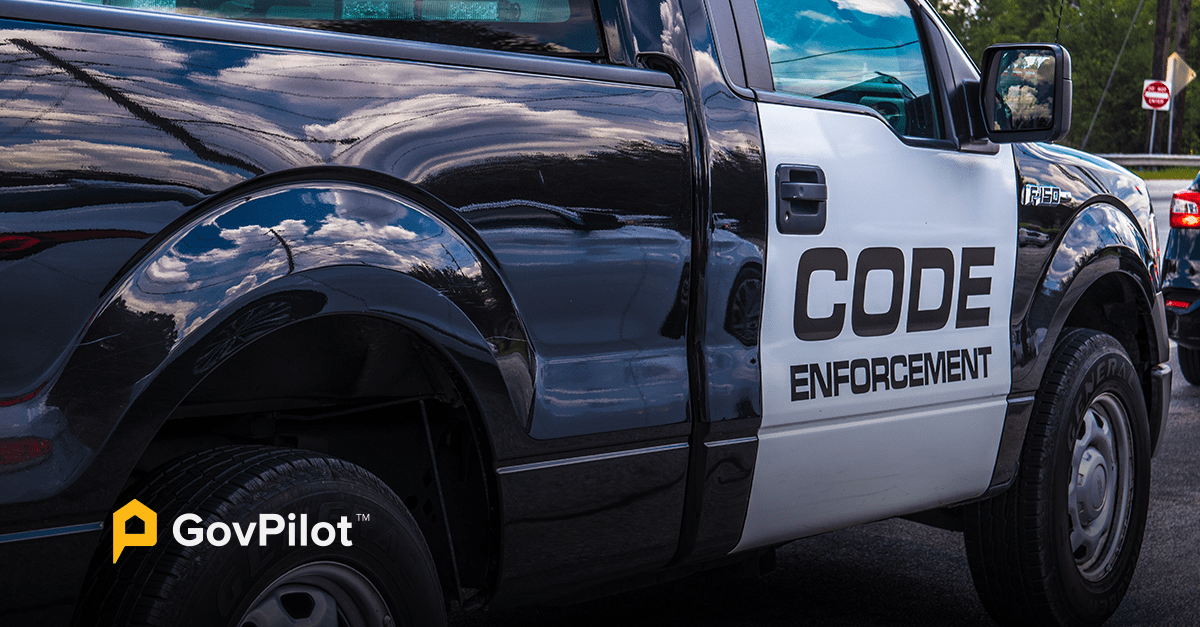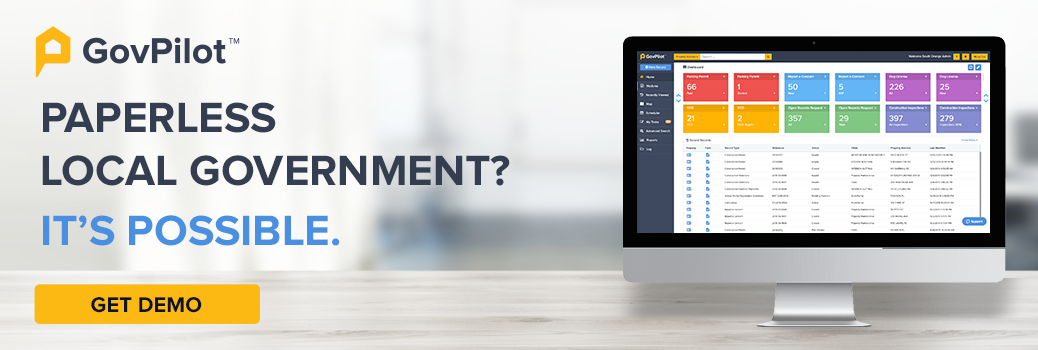You’re walking through your neighborhood when you notice something seems off. Maybe someone’s roof is all but falling in on itself, and you’re concerned about the safety of neighborhood kids. Or perhaps you see a pile of rubbish that could very well make its way into a nearby stream come the next storm.
Enter: your local code enforcement office.
It might not be glamorous, but effective code enforcement is critical for local governments. Local ordinances keep a community safe, healthy, and livable for all. Code enforcement officers ensure compliance with municipal codes, perform essential inspections, and even generate fine revenue from violations. But many local governments rely on antiquated processes and technology to enforce ordinances. As a result, violations slip through the cracks, staff must navigate inefficient inspections, and citizens grow frustrated with the untimely processing of complaints.
Fortunately, there are steps you can take to improve these processes. This guide discusses how local government departments can use inspection applications and code enforcement technology to modernize and automate processes for the community’s benefit.
What Does the Local Government Code Enforcement Department Do?
A local government code enforcement agency is responsible for ensuring that a community’s businesses, developers, and residents abide by a city or county’s established codes. And local government ordinances go far beyond aesthetics to support the overall well-being of a community. Municipal code enforcement includes a focus on the following:
- Building and development
- Public health
- Environmental health, such as proper disposal of waste
- Property maintenance
- And more
The employees in charge of code enforcement may belong to a department like Planning, or a local government could have an independent Code Enforcement Department. Whether or not this is the case often depends on the size of a city or county and how a local government wishes to structure itself.
Code enforcement strategies
Code enforcement officers use proactive and reactive strategies to ensure businesses and residents comply with each neighborhood code. For example, someone might call the code enforcement office after seeing a pile of trash near a stream. A code enforcement officer will then visit the site, determine if someone is violating a code, and issue any applicable fines.
Alternatively, they might walk or drive through a city or county to provide neighborhood code enforcement. The code enforcement officer can then issue fines to property owners if they find something amiss.
Code enforcement officers may also work with other departments to inspect new construction and ensure that a builder or developer complies with the most up-to-date building codes. You can read our Building Inspections 101 : How Local Governments Can Ensure Public Safety guide to learn more.
How Code Enforcement Software Can Help Improve Processes
Local government code enforcement officers are responsible for enforcing many ordinances. As such, relying on inefficient processes to address complaints and collect fines is counterproductive to ensuring straightforward code enforcement.
Fortunately, code enforcement software makes it easier for local governments to ensure that businesses and residents maintain compliance with their ordinances. Let’s dive into some of the inspection software features that make this possible below.
Read GovPilot's guide to citizen concern reporting software.
Assignment of to-dos
With so much to do, your local government code office needs a straightforward way to assign, manage, and track tasks to code enforcement officers. GovInspect provides precisely that tool.
This code enforcement technology automatically assigns tasks to code enforcement officers, so they know exactly where they’re supposed to be (and when). Employees can even take notes within the app, including while out in the field, to make their workday more efficient.
Inspection application
Residents can use GovPilot’s software to complete online inspection applications rather than filling out and submitting paper documents. This tool ensures that residents and business owners can easily comply with local government regulations and saves time since you don’t have to sift through paper documents. By making it easy for businesses to request inspections, GovPilot also helps you foster strong relationships with private-sector partners.
Additionally, GovPilot’s complaint management software allows residents and businesses to submit code violations they see in their community. As a result, code enforcement officers can quickly address any issues as constituents partake in the civic engagement process right from an app on their phones to report concerns.
In-person fine collection
Local government code enforcement officers encourage a more efficient fine and fee collection process by collecting payment in person. GovPilot’s software integrates with multiple payment processing vendors, making it possible for staff to process payments on-site. Additionally, residents can submit payment online on your government website.
A mechanism to collect fees in person or online increases the number of payments you receive (bills won’t fall to the bottom of a citizen’s pile!) and reduces the time local government employees spend tracking down payments.
How Can Local Governments Streamline Fee & Fine Processing? Read on to find out.
Automated data storage
Automated data storage helps you track essential information that facilitates more efficient and effective code enforcement. Using GovPilot, staff can easily access historical records about a property and its owners. This information can even be shared across departments, so individuals in the code enforcement officers have the same information as those in the planning or housing departments. As a result, automated data storage makes collaboration easier for individuals in other departments.
Pro Tip: Cloud-based data storage is the best way to keep your code enforcement data safe and secure from data breaches. Learn more in the Local Government Cybersecurity and Government Data Breach Prevention resources.
GIS mapping of specific properties/areas
Imagine if you could see where code enforcement violations were concentrated in your city and county. Well, GovPilot makes this possible with GIS mapping software. Because you can see which geographic areas have the highest number of violations, you can also identify strategies that will help you improve compliance.
GIS maps help with enforcing ordinances too. When constituents report concerns from their GIS map, the scheduling app for code enforcement officials will notify them of the exact location in which the complaint was reported.
Excited to learn more about code enforcement technology? Check out our article, Everything You Need to Know About Modern Government Technology.
How to Use Code Enforcement Data to Make Educated Decisions
You can’t improve processes you don’t understand. Local governments must use code enforcement data to make educated decisions about their everyday operations and procedures. As such, data collection should go hand-in-hand with regular and effective government strategic planning.
A clear understanding of your long-term goals and current challenges allows you to identify the data types that will help you assess progress toward meeting strategic objectives. In particular, key performance indicators (KPIs) enable you to determine what parts of your code enforcement are streamlined and which may need some work.
Let’s discuss KPIs local government code enforcement offices should be tracking next.
Identify and Track KPIs to improve your locality’s code enforcement
Identifying and tracking key performance indicators allows your department to better understand its operational strengths and weaknesses. When determining what data to track, think beyond basic output measures like how many fines are collected annually.
Instead, consider metrics that will help you assess the efficiency and effectiveness of your department. These rich data points provide more comprehensive information about how your department uses its resources and whether it’s achieving its goals.
For example, monitoring the number of annual violations doesn’t provide you with meaningful data. Instead, it only leads to more questions like “What type of violations? Did they result in a fine? Were there repeat offenders?”
In contrast, measuring data like the following provides rich detail that can help your department identify areas for improvement:
- Average time between citizen complaint and code enforcement inspection
- Average time inspectors spend per case
- Average cost per fine
- % of fines or fees paid on time
- % of unsafe structures brought into compliance
You can also learn more about performance management and KPIs in these Government KPIs: Setting Measurable Goals in the Public Sector and Performance Management for City Managers 2022 guides.
Use GovPilot to Modernize Your Code Enforcement Department and Processes
Efficient and effective code enforcement is vital to ensuring a community’s health and long-term vibrancy. GovPilot’s inspection software provides valuable tools that make it as straightforward as possible for residents to submit concerns and for municipal staff to enforce each neighborhood code.
Ready to learn more about how GovPilot can modernize your code enforcement processes for your local government agency? Book a consultation today.
Local Government Code Enforcement FAQs
What is local code enforcement?
Local code enforcement ensures that businesses and residents in a community abide by local ordinances. These ordinances may include rules about property maintenance, zoning (such as what can be built and where), public health, the environment, and more.
Why do code enforcement departments need to innovate on outdated processes?
Unfortunately, inefficient processes are one of the many challenges local governments face today. If you’re like most local government employees, your time is limited and you’re trying to address multiple priorities simultaneously. Innovating outdated processes makes it easier for you to manage these priorities and enforce code compliance across your municipality for a safer, healthier community.
Explore the Six Keys to Local Government Innovation to learn more.
What data does the code enforcement department need to track?
Local government code enforcement departments should pay attention to data that helps them track their performance and ensure residents maintain compliance with codes. This data may include output metrics like the total number of permits issued and the number of inspections conducted. We recommend you take things a step further though and consider some of the efficiency and effectiveness measures listed in the article above.
How can code enforcement officers modernize the fine collection process? Why do they need to?
By streamlining your municipal code enforcement, you can modernize the fine collection process and make it easy for your local government to hold residents accountable to local ordinances. Modern government fee and fine processing models increase the likelihood that residents and businesses will pay the fines they incur.
Read on:










